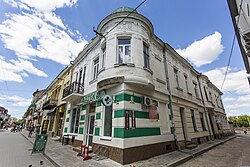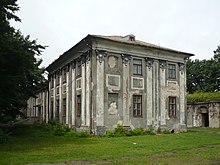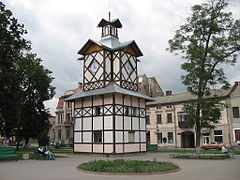Brody
Brody
Броди | |
|---|---|
 A building in central Brody | |
| Coordinates: 50°04′59″N 25°08′52″E / 50.083141°N 25.147651°E | |
| Country | |
| Oblast | Lviv Oblast |
| Raion | Zolochiv Raion |
| Hromada | Brody urban hromada |
| Established | 1084 |
| Town rights | 1584 |
| Area | |
| • Total | 8.67 km2 (3.35 sq mi) |
| Population (2022) | |
| • Total | 23,134 |
| • Density | 2,700/km2 (6,900/sq mi) |
Brody (
Brody is the junction of the
History
The first mention of a settlement on the site of Brody is dated 1084 (Instructions by Vladimir Monomach). It is believed to have been destroyed by Batu Khan in 1241.
Polish Kingdom
From 1441 Brody was the property of different feudal families (Jan Sieniński; from 1511, Kamieniecki).
Brody was granted

From the 17th century until the Holocaust the city was populated not only by

In 1648, during the
In 1704, Brody was purchased by
Austrian Empire

As a result of the
Polish Republic
In 1919, Brody became part of the
World War II
After the
The Jews in Brody
| Jews in Brody according to Austrian-Hungarian Census[19] | |||||||
| Year | total pop. | Jews | Share | ||||
|---|---|---|---|---|---|---|---|
| 1869 | 18,700 | 15,138 | 80.9% | ||||
| 1880 | 20,000 | 15,316 | 76.3% | ||||
| 1890 | n. a. | n. a. | n. a. | ||||
| 1900 | 16,400 | 11,854 | 72.1% | ||||
| 1910 | 18,000 | 12,150 | 67.5% | ||||
A crossroads and a Jewish trade center in the 19th century, the city is considered to be one of the
The promulgation of the May Laws, and the massive exodus of Russian Jews which was its result, took the leaders of Western Jewry completely by surprise. Throughout 1881, hundreds of immigrants kept arriving in Brody daily. Their arrival placed the existing Austrian and German-influenced ethnic Jews in a quandary. The comfortable middle-class Jewish community of Central and Western Europe looked instinctively to the Alliance Israélite Universelle, the world's largest and most respected Jewish philanthropic agency, to bring order out of chaos, to cope with the huge influx of newcomers.[20]
Throughout centuries of Jewish life in Brody until the murderous events of the Holocaust, Jews and Gentiles lived a mostly segregated life, with distinct and separate social as well as religious life.
Holocaust in Brody


When German troops occupied the city on 1 July 1941, the Jewish population of some 9,000 was forced to wear an arm band with the yellow badge. Two hundred fifty intellectuals were arrested on 15 July 1941 and shot two days later at the Jewish cemetery after being brutally tortured. Encouraged by German occupation authorities, the Ukrainian population started a pogrom in August 1941, looting Jewish possessions. The Judenrat had to provide labor for repairs and maintenance on the roads and bridges as well as for work in army depots. From December 1941 young people were arrested on the streets and sent to forced labor camps in the vicinity.
In September 1942 the
After the war
During the
The Brody Museum of History and District Ethnography was founded in 2001.
Until 18 July 2020, Brody was the administrative center of Brody Raion. The raion was abolished in July 2020 as part of the administrative reform of Ukraine, which reduced the number of raions in Lviv Oblast to seven. The area of Brody Raion was merged into Zolochiv Raion.[21][22]
Geography
Climate
| Climate data for Brody (1981–2010) | |||||||||||||
|---|---|---|---|---|---|---|---|---|---|---|---|---|---|
| Month | Jan | Feb | Mar | Apr | May | Jun | Jul | Aug | Sep | Oct | Nov | Dec | Year |
| Mean daily maximum °C (°F) | 0.3 (32.5) |
1.6 (34.9) |
6.5 (43.7) |
14.4 (57.9) |
20.5 (68.9) |
23.0 (73.4) |
24.9 (76.8) |
24.5 (76.1) |
19.0 (66.2) |
13.4 (56.1) |
6.3 (43.3) |
1.5 (34.7) |
13.0 (55.4) |
| Daily mean °C (°F) | −2.5 (27.5) |
−2.0 (28.4) |
2.1 (35.8) |
8.5 (47.3) |
14.3 (57.7) |
17.1 (62.8) |
18.8 (65.8) |
18.1 (64.6) |
13.3 (55.9) |
8.5 (47.3) |
2.9 (37.2) |
−1.4 (29.5) |
8.1 (46.6) |
| Mean daily minimum °C (°F) | −5.9 (21.4) |
−5.4 (22.3) |
−1.8 (28.8) |
3.1 (37.6) |
8.3 (46.9) |
11.4 (52.5) |
13.1 (55.6) |
12.4 (54.3) |
8.4 (47.1) |
4.3 (39.7) |
−0.2 (31.6) |
−4.4 (24.1) |
3.6 (38.5) |
| Average precipitation mm (inches) | 32.8 (1.29) |
39.7 (1.56) |
39.7 (1.56) |
46.6 (1.83) |
75.5 (2.97) |
90.2 (3.55) |
104.7 (4.12) |
70.0 (2.76) |
67.5 (2.66) |
45.2 (1.78) |
41.1 (1.62) |
42.0 (1.65) |
695.0 (27.36) |
| Average precipitation days (≥ 1.0 mm) | 9.2 | 10.2 | 9.5 | 8.5 | 10.7 | 11.8 | 10.7 | 8.7 | 8.8 | 8.3 | 9.6 | 10.7 | 116.7 |
| Average relative humidity (%)
|
80.9 | 80.9 | 76.7 | 69.4 | 69.4 | 72.8 | 74.2 | 74.8 | 78.7 | 79.2 | 82.7 | 83.5 | 76.9 |
| Source: World Meteorological Organization[23] | |||||||||||||
Gallery
-
Administration building, former branch of thePrague Credit Bankbefore WWI
-
The old synagogue (ruins) of Brody
-
Clock tower at the market square
-
Pedagogical College
-
Tyszkiewicz Palace
-
Saint George church in Brody
-
Church of the Nativity of the Virgin Mary
-
Exaltation of the Holy Cross church
-
Church of the Holy Trinity
-
Brody Gymnasium
Notable people
- Adolph Baller, pianist
- Iuliu Barasch, physician
- Ephraim Zalman Margolioth (author of Mateh Ephraim) (1762–1828)
- Aryeh Leib Bernstein (1708–1788), Chief Rabbi of Galicia
- Berl Broder (Berl Margulis), singer
- Oscar Chajes, chess player
- Zvi Hirsch Chajes, rabbi and talmudist
- Petro Fedun-Poltava (1919–1951), ideologist of Ukrainian national liberation fight 1940–50 years
- Kalman Kahana (1910–1991), Israeli politician
- Leo Kanner, Austrian psychiatrist and physician known for his work related to autism
- Hans Kelsen (father's birthplace)
- Shlomo Kluger, rabbi
- Stanisław Koniecpolski, Polish military commander, magnate, and royal official
- Józef Korzeniowski (1797–1863), Polish writer
- Nachman Krochmal, Jewish philosopher
- Yechezkel Landau, rabbi
- Max Margules, meteorologist
- Fabius Mieses (1824–1898), writer
- Jacques Mieses, with parents from Brody; he was born in Leipzig
- Nachman of Horodenka, Hasidic leader
- Amalia Nathansohn-Freud (1835–1930), mother of Sigmund Freud
- Dmytro Pyluk (1900–1985), Ukrainian painter and film producer [24]
- Joseph Ludwig Raabe, mathematician
- Elazar Rokeach, rabbi
- Jakob Rosanes, mathematician
- Joseph Roth (1894–1939), writer
- Dov Sadan (1902–1989), scholar of Yiddish literature, Hebrew Literature and Jewish Folklore
- Myron Tarnavskiy (1869–1938), general of Ukrainian Galychina Army
- Ivan Trush (1869–1941), Ukrainian artist
- Feliks West (1846–1946), Polish publisher
- Daniel Abraham Yanofsky, chess player. See German-language article.
- Catholicism
- Oksana Lyniv, Ukrainian conductor, since February 2017 is a chief conductor of the Graz Opera
Nearby towns
See also
References
Notes
- ^ "Бродовская городская громада" (in Russian). Портал об'єднаних громад України.
- ^ Чисельність наявного населення України на 1 січня 2022 [Number of Present Population of Ukraine, as of January 1, 2022] (PDF) (in Ukrainian and English). Kyiv: State Statistics Service of Ukraine. Archived (PDF) from the original on 4 July 2022.
- ^ a b Sadok Barącz, Wolne miasto handlowe Brody, Lwów, 1865, p. 7 (in Polish)
- ^ Słownik geograficzny Królestwa Polskiego i innych krajów słowiańskich, Tom I, Warsaw, 1880, p. 372 (in Polish)
- ^ Barącz, Op. cit., p. 9-10
- ^ Barącz, Op. cit., p. 10
- ^ Barącz, Op. cit., p. 11
- ^ a b c d e f "Brody". Encyklopedia PWN (in Polish). Retrieved 15 October 2019.
- ^ Barącz, Op. cit., p. 17-18
- ^ Barącz, Op. cit., p. 21-22
- ^ Barącz, Op. cit., p. 22
- ^ Barącz, Op. cit., p. 17
- ^ Barącz, Op. cit., p. 27-28
- ^ Barącz, Op. cit., p. 28-29
- History of the Rus.: "А по симъ правиламъ и обширный торговый городъ Броды, наполненный почти одними Жидами, оставленъ въ прежней свободѣ и цѣлости, яко признанный отъ Рускихъ жителей полезнымъ для ихъ оборотовъ и заработковъ, а только взята отъ Жидовъ умѣренная контрибуція сукнами, полотнами и кожами для пошитья реестровому войску мундировъ и обуви, да для продовольствія войскъ нѣкоторая провизія."
- ^ Nowości Illustrowane, no. 5, 1904, p. 6 (in Polish)
- ^ Zygmunt Zagórowski, Spis nauczycieli szkół wyższych, średnich, zawodowych, seminarjów nauczycielskich oraz wykaz zakładów naukowych i władz szkolnych. Rocznik II, Książnica-Atlas, Warsaw-Lwów, 1926, p. 167 (in Polish)
- ^ Wschód, no. 2, 1936, p. 4 (in Polish).
- ^ Ergebnisse der Volkszählungen der K. K. Statistischen Central-Kommission u.a., in: Anson Rabinbach: The Migration of Galician Jews to Vienna. Austrian History Yearbook, Volume XI, Berghahn Books/Rice University Press, Houston 1975, S. 46/47 (Table III)
- ^ Howard M. Sachar
- ^ "Про утворення та ліквідацію районів. Постанова Верховної Ради України № 807-ІХ". Голос України (in Ukrainian). 2020-07-18. Retrieved 2020-10-03.
- ^ "Нові райони: карти + склад" (in Ukrainian). Міністерство розвитку громад та територій України.
- ^ "World Meteorological Organization Climate Normals for 1981–2010". World Meteorological Organization. Archived from the original on 17 July 2021. Retrieved 17 July 2021.
- ^ "Archives Search - Library and Archives Canada". Archived from the original on 2013-06-23.
Sources
- Howard M. Sachar, The Course of modern Jewish history. Vintage Books (a division of Random House) Chapter 15
- Kuzmany, Börries, Brody: A Galician Border City in the Long Nineteenth Century (Brill, Leiden/Boston 2017). The German version is open access: Kuzmany, Börries: Brody. Eine galizische Grenzstadt im langen 19. Jahrhundert (Böhlau, Vienna/Cologne/Weimar 2011). )
- Hamann, David. David Hamann: Ein Billett von Brody über Berlin nach New York: Organisierte Solidarität deutscher Juden für osteuropäische jüdische Transmigrant*innen 1881/82 (= Europäisch-jüdische Studien Bd. 67) (Berlin, Boston: De Gruyter Oldenbourg 2023).
External links
- Brody in the Encyclopedia of Ukraine
- (in Polish) Brody in the Geographical Dictionary of the Kingdom of Poland (1880)
- (in English) About Brody museum Archived 2012-02-20 at the Wayback Machine
- (in Ukrainian) Brody site Archived 2020-08-03 at the Wayback Machine
- Brody, Ukraine at JewishGen
- (in English) ShtetLinks Site for Brody
- (in English) Brody under Austrian Rule
- (in Russian) Photo Gallery of Brody (1.03.2008, 51 photos) Archived 2012-05-24 at the Wayback Machine
- Live webcam of the Market Square (ploshcha Rynok).















